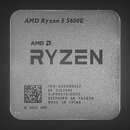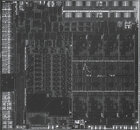Friday, August 13th 2021

AMD Ryzen 5 5600G APU Die Shots Published
We have recently seen the first high-resolution die shots of AMD's Ryzen 5 5600G Cezanne APU thanks to the work of Fritzchens Fritz. The photos show the internal layout of the processor with its Zen 3 CPU, Vega GPU, and corresponding components. To get these shots, the chip had to be delidded by removing the IHS which has been made harder with the move to a soldered design. The Ryzen 5 5600G is a 6 core, 12 thread part with 7 Vega GPU cores which can all be seen in the annotated diagram of the die created by Locuza. The diagram also shows the suspected locations of various PCIe 3.0, and memory controllers along with cache placements for the CPU and GPU. The processor is manufactured on TSMC's 7 nm process and features a total of 10.7 Billion transistors packed into the 180 mm² die.
Sources:
Fritzchens Fritz, @Locuza_





31 Comments on AMD Ryzen 5 5600G APU Die Shots Published
Interestingly enough, both the 5600G and 5700G I've gotten my hands on both have this weird square imprint in the middle of the heatspreader, demarcated by a thin line that basically forms a square over where the capacitor rows are. Not seen it on any other AM4 APU or CPU, doesn't seem to be residue either that can be wiped off. Seems like all the launch parts for Cezanne were made in the same week, 2127.
But yeah, nothing new. Good blob of paste in the middle like any other monolithic chip, and off to the races. So far the cores seem to run about the same temp as Renoir, are much more consistent core-to-core (unlike chiplet Zen 3 where I've seen upwards of 10C core deltas), and as always Vega 7/8 stays cool as ever even at 2300MHz+.
@R0H1T in case it wasn't obvious, they just delved further into one of the cores to show you its component parts..........not that it matters since it's the wrong APU.
Look closely at the cores, cache, and CUs with detailed labeling, and you'll see that they all have identical layouts to the others.
Also @Uskompuf, the labeled image on the OP is of Renoir, not Cezanne.
Here's the labeled image for the Cezanne die.
The last one had 2 ccx
Note the identical GPU layout and the lack of a gap in the cores on Cezanne.
I also find the amount of unused space on Cezanne to be interesting. They needed a bigger die for the larger CPU component, but didn't have enough stuff to fill the extra space that it left them with.
But aside from that, holy they weren't kidding when they said they just made a bunch of "optimizations". I was previously speculating that they literally drag-and-drop Zen 3 into Renoir, literally nothing changed on the GPU/IF side. Which is pretty much the experience so far, everything down to the CLDOs and VDDCR_GFX works the same way, only things different relate to the Zen 3 cores (Curve Optimizer). When not CPU-limited Vega 7 behaves the exact same.
And they added a iGPU Curve Optimizer as well, works basically the same way, but pretty much useless given the Vega core speeds that every 5600G/5700G seems to be able to hit manually.
Look at the unlabeled component below the GPU on Renoir; notice how the unused area on Cezanne has the same shape as it, and how that component is lower on that die? Also, note the gap underneath the PCIe lanes that doesn't exist on Renoir.
And as @tabascosauz pointed out, Cezanne does have a different IMC. The other support components look the same. They were just moved around to accommodate the larger CPU.
I'm assuming you're on a dGPU? @glnn_23 got up to about 4800 16-16-16, but I suppose B-die timings aren't helping us either. I wish I had a good kit of Rev.B on hand, but it would no longer be an apples-to-apples comparison as I sent the 5600G back.
How high it works highly depends on the motherboard. I had the best results on Strix B550I-Gaming. It was about 1-2 memory ratios better (depends on the memory kit) than CHVIII Impact or any other board that I tested.
The attached screenshot is on CHVIII Impact. It doesn't support IGP so I had to use a discrete one. So far I have had no time to check different IC so only Micron B in tests. I always had problems passing DDR4-4866 on a pretty good Samsung. Generally, for high clocks, APUs like Micron on ambient temps.
They could chop off two CPU cores and 1/4 the L3 cache to give that space to probably another 12 Vega CUs.
6C/12T with Vega20 would be a far better product than 8C/12T with cripplingly-slow graphics. Here's a quick-n-dirty 6C/12T Vega20 mockup just shuffling a few blocks around with minimal overlap:
Otherwise this is an 8c16t or am I on drugs
Also an 8th vega in there, btw
Hell I don't know, even Vega12 would be an improvement, we just don't get enough GPU power in these things and the only reason people are buying them instead of the regular Zen3 chips is because they want the GPU included.